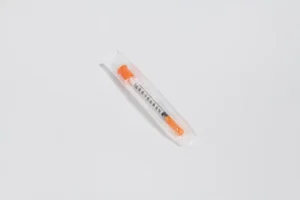Blog
BPC-157 Mechanism of Action: The Healing Peptide Explained

BPC-157’s mechanism of action might sound complicated, but it’s actually quite interesting.
Short for Body Protection Compound 157, BPC-157 is a peptide that’s naturally found in your gastric juices. It’s something your body already makes to protect and heal itself.
People believe it may help repair tissue, heal your gut, and reduce inflammation.
Some athletes swear by it for quicker injury recovery, bio-hackers are experimenting with it to optimize health, and those dealing with chronic pain are hopeful it could offer some relief.
But, how exactly does BPC-157 work, and is it safe? Could there be unwanted effects, like cancer or tumor growth? What about the immune system connection? Does it strengthen your body’s defenses?
In this article, we go over everything you need to know. Learn how BPC-157 works, discover its potential benefits and risks, and find out why it’s one of the most talked-about peptides in wellness circles.
BPC-157 mechanism of action: How it works in your body
Understanding BPC-157’s mechanisms of action can give you an idea of why this peptide has become so popular for healing and recovery. Here’s what it’s reported to do:
- Stimulates angiogenesis (formation of new blood vessels).
- Enhances nitric oxide pathways, improving circulation.
- Balances gene expression, speeding up cellular repair.
- Influences growth hormone receptors, promoting tissue regeneration.
- Offers healing effects to tendons, ligaments, gut, and brain tissues.
BPC-157 influences various processes in your body. It mainly promotes healing by improving blood flow, repairing tissues, and adjusting certain genes.
Angiogenesis and improved circulation
First, let’s talk about angiogenesis, which means “creating new blood vessels”. This process is important for healing injured tissues.
BPC-157 stimulates angiogenesis by enhancing pathways with nitric oxide. Nitric oxide relaxes your blood vessels, improving circulation and oxygen supply to damaged areas and helping speed up repair.
Gene modulation and cellular repair
BPC-157 works at the cellular level, boosting cellular repair by influencing gene expression. Basically, it tells certain genes to turn on or off, encouraging your cells to regenerate and heal faster.
This gene modulation isn’t limited to muscles and tendons.
Gut protection and epithelial repair
BPC-157 may also positively impact your gut lining and even brain tissue. Some users report fewer cramps, less reflux, and noticeable relief from leaky‑gut-type symptoms after consistent use.
In a 2023 study, BPC-157 significantly sped up healing of rats’ intestinal lining, supporting its proposed effects on gut health.
Growth‑hormone receptor interaction
BPC-157 interacts with growth hormone receptors, vital for repairing and building tissues in your body. This peptide may improve your body’s natural recovery abilities by balancing these receptors, speeding up how quickly you bounce back from injury.
Tissues most affected
BPC-157’s mechanism of action impacts various tissues, including:
- Tendons and ligaments: Improves collagen production and strengthens connective tissues.
- Gut tissue: Repairs damage to intestinal linings, potentially relieving symptoms of digestive disorders.
- Brain tissue: May support neuronal regeneration, offering neuroprotective effects.
What can BPC-157 help with?
Wondering what BPC-157 can actually do for you? People mostly use this peptide for its healing and recovery potential, not muscle growth.
Joint and ligament healing
One of the biggest reasons people use BPC-157 is for joint and ligament healing. If you’ve ever dealt with stubborn injuries like tendonitis or strains that never seem to fully heal, this peptide could be a game-changer.
The BPC-157 mechanism of action reportedly boosts blood flow, reduces inflammation, and encourages your body’s natural repair process.
Inflammation control
This peptide doesn’t just mask pain: it genuinely tackles inflammation at its source.
Less inflammation means less pain, quicker healing, and stronger, healthier tissues. This is why some athletes and fitness enthusiasts use BPC-157: it can help get you back in the game faster.
Gut‑health benefits
Another area where BPC-157 shows promise is gut health. People with digestive issues, from leaky gut to ulcers, have reported significant improvements.
This makes sense because BPC-157 naturally exists in your stomach juices to help repair the gut lining.
Brain and nerve support
Some researchers have even looked at BPC-157’s potential to help heal traumatic brain injuries. Although human studies haven’t caught up yet, early rat studies suggest it might support brain tissue recovery and protect nerve cells after trauma.
Immune modulation
A study suggests BPC-157 could have immune-balancing effects, helping your body regulate inflammation better.
While the results are promising, a lot of evidence is anecdotal or from animal studies. Stay informed and realistic about expectations.
BPC-157 and your immune system
The link between BPC-157 and your immune system mostly comes down to how it regulates inflammation.
Cytokine regulation
When you’re injured, or after surgery, your body releases proteins called cytokines. These cytokines tell your immune system to ramp up and repair the damage. Sometimes, they go a bit too far, creating excessive inflammation.
The BPC-157 peptide seems to help balance this out by keeping cytokines under control, lowering inflammation without weakening your natural immune response.
BPC-157 could calm the immune system when it’s overly active, potentially relieving symptoms related to chronic inflammation or autoimmune reactions.
Oxidative‑stress reduction
BPC-157 may also reduce oxidative stress, a harmful build-up of unstable molecules that can damage your cells and slow healing. By protecting your tissues from oxidative stress, it might help you bounce back faster from surgery or injuries.
It’s important to remember that research is still in the early stages. However, the potential immune-balancing effects of BPC-157 definitely make it worth watching.
Does BPC-157 cause tumor growth?
The main concern about tumor growth comes from BPC-157’s role in the creation of new blood vessels. Angiogenesis is essential for healing wounds because fresh blood vessels deliver nutrients and oxygen to damaged tissues.
Theoretically, this process could also support the growth of existing tumors, supplying them with blood to fuel their growth. This is why some people wonder if BPC-157 might inadvertently boost tumor development.
What studies say so far
So far, clinical research hasn’t shown a direct link between BPC-157 and tumor growth. Most of the anxiety stems from studies in animals and the broader fear around substances that stimulate blood vessel formation.
While some rat studies raised initial worries, none have shown that BPC-157 directly causes or speeds up cancer development. There’s no solid evidence showing that BPC-157 increases the risk of cancer in humans.
Angiogenesis on its own does not cause cancer. It supports tissue growth, which tumors can exploit, but that doesn’t mean BPC-157 creates tumors.
That said, we still need more detailed human studies to fully clarify these questions. While current clinical and anecdotal evidence hasn’t shown an increased risk, caution makes sense, especially if you have a history of cancer or concerns about tumors.
Does BPC-157 cause cancer?
A common question when exploring peptides is: does BPC-157 cause cancer? The short answer, based on current research, is no. There’s no evidence right now to suggest that BPC-157 directly causes cancer.
The worry around cancer mostly stems from BPC-157’s ability to support angiogenesis, or the growth of new blood vessels. Technically, boosting blood vessel formation might also feed existing tumors, which is why people worry it could link BPC-157 to tumor growth).
Current evidence
Here’s the important distinction: a theoretical risk isn’t the same as proven harm. So far, studies haven’t found that BPC-157 promotes tumor growth or triggers cancer development.
While concerns about angiogenesis and cancer are understandable, the clinical data available today hasn’t shown a direct connection between BPC-157 use and cancer formation.
Researchers have consistently noted that BPC-157 seems safe and effective for tissue healing, gut repair, and inflammation reduction, without raising alarms about cancer.
Still, it’s important to be clear that long-term data in humans is limited. Early findings look promising and reassuring, but more extensive, long-term human studies would give us a definitive answer.
Safety, side effects, and proper use
When exploring BPC-157, safety is always a top concern. Thankfully, most short-term studies have reported no major side effects, which is reassuring for people curious about trying it.
However, it’s important to know what minor issues could pop up and how to use peptides safely.
Some people report mild side effects, like dizziness, nausea, or irritation at the injection site. These symptoms usually resolve quickly and aren’t considered serious.
Because of BPC-157’s mechanism of action, it interacts naturally with your body’s healing processes, which could explain why significant side effects are rare.
Also, since BPC-157 might influence your immune response, it’s a good idea to watch how your body responds, especially if you have existing health issues or autoimmune conditions.
One critical point about peptide safety: always buy from trustworthy vendors who offer quality assurance. Unfortunately, not every source is reliable, so doing your homework is essential.
Typical usage involves subcutaneous injection of 200–500 micrograms (µg) daily for 4–6 weeks. Always rotate injection sites and never exceed recommended doses without medical supervision.
Always check local guidelines and speak with a healthcare professional if you’re unsure. Stay informed, source responsibly, and you’ll minimize risks while exploring BPC-157.
Real user experiences and testimonials
A search through r/Peptides, bodybuilding.com logs, and wellness Discords reveals a steady stream of success tales:
- A trail‑runner nicknamed “PeakGeek” says a partial Achilles tear that had him limping for months “felt 80% better after four weeks on 250 µg a day; my physio couldn’t believe the ultrasound.”
- A power lifter on EliteFTS writes that his nagging golfer’s elbow “stopped barking after the second pin,” letting him hit new PRs.
- One person with IBS reported that ten days of oral BPC‑157 “calmed the cramps I’d battled for years.”
- Another poster claims fewer colds since starting, hinting at possible BPC‑157 immune system support.
- Even pets make cameos: a veterinarian shared photos of a dog’s stitched wound closing in half the expected time.
Others echo these experiences, highlighting reduced joint pain, better gut health, and quicker bounce-back from injuries. Across hundreds of anecdotes, the same themes pop up:
- Faster soft‑tissue and tendon repair
- Noticeably reduced inflammation and pain
- Calmer gut and fewer digestive flare‑ups
- A mild lift in mood and overall well‑being
It’s important to mention that experiences can vary. Not everyone notices dramatic improvements, and a few people question whether some benefits might be partially placebo-driven.
Some forum discussions focus on safety concerns, like if BPC-157 causes cancer. Despite theoretical fears around cancer risks due to angiogenesis, nobody has reported personal experiences linking this peptide to tumor growth or cancer.
Overall, real-world testimonials mostly lean toward positive results, with many satisfied users recommending it for recovery and pain relief. However, it’s always smart to stay realistic and remember everyone’s body responds differently.
Should you try BPC-157?
By now, you’ve learned about the impressive healing potential tied to the BPC-157 mechanism of action. Its reported benefits include quicker tissue repair, inflammation control, gut health support, and immune balance.
Its low side-effect profile is also reassuring, making it attractive to those looking for alternative healing options.
However, it’s important to keep a balanced perspective. Most of what we know about BPC-157 comes from preclinical research (mainly animal studies) and anecdotal user experiences.
Some theoretical concerns, like BPC-157’s link to tumor growth, aren’t supported by current evidence, but still highlight the need for more human research. If you’re seriously considering BPC-157, approach it responsibly.
Talk to a healthcare provider first, especially if you’re dealing with chronic injuries, pain, or autoimmune issues. Under professional guidance, BPC-157 could be a valuable addition to advanced recovery strategies.
BPC-157 shows great promise, and many people report impressive results, but always make informed decisions backed by professional medical advice.
Ready to take your recovery to the next level?
At LivvNatural, we offer high-quality BPC-157 peptides for healing, performance, and wellness. Whether you’re recovering from injury, managing inflammation, or want to support gut and joint health, BPC-157 could be the game-changer you’ve been waiting for.


